The post 10 Facts About The Colorado Grizzly appeared first on Bear Informer.
]]>
| 1 | Now extinct, but once common |
Barring a miracle, there are currently no wild grizzly bears roaming the state of Colorado. The last confirmed sighting was 1979, but just as the fur traps and wooden lodges of 19th century mountain men gave way to steel skyscrapers and GPS collars, the bear situation in Colorado was once very different. 500 years ago, the range of the grizzly bear in North America stretched continuously from the western tip of Alaska to the Sonora mountains of Mexico. Colorado, with its rocky canyons, 8 foot deep snowdrifts, and haunted mountaintop hotels, was true bear country. The bears spent decades terrorising European settlers and mountain men, and centuries terrorising native American tribes.
One legend, for example, tells of a stranger who purchased a rifle from Dr G.H. Graves in Canon City in 1872, and headed off into the Collegiate Peaks to make his fortune. This young man was never heard of again, until a few years later, a new posse of hunters ventured into the mountains and came across the intertwined skeletons of a human being and gigantic grizzly bear. Beneath the skeletons lay the rifle from Dr Graves’ shop, with 5 inches of gunpowder below the bullet ready to be fired. Naturally, Graves retrieved his gun for resale, and told the story with relish for years afterwards.
| 2 | Tales |
Unlike the Californian grizzly (ursus arctos californicus), the grizzly bears of Colorado belonged to the standard grizzly subspecies (ursus arctos horribilis). The Rocky mountains and San Juan mountains were their main habitat, and they were once so common that extinction was inconceivable. One mystery which still exists is their size. With no non-stop salmon feasts like in Alaska, the Colorado grizzly was probably more in line with Yellowstone’s bears, being forced to eat berries, roots, and hard to catch deer. Yet legends of colossal 1000 pounders were still common among fur trappers.
One story took place in 1870 by north Boulder Creek in the Colorado front range, near the homestead of prominent politician Emery DeLonde (rusty buildings whose ruins still stand today). Thomas Cameron was hunting grouse with some friends, and as he camped out at midday, his tiny little dog ran ahead and started scratching the dirt while barking loudly. Cameron assumed that he’d flushed out some prey, and dashed to the spot with rifle in hand, but was proven wrong when a huge grizzly bear appeared. He fired a musket ball into its shoulder, and was narrowly saved when his friend Mr Jones appeared and fired a shot into its brain.
The grizzly’s carcass weighed a staggering 900 pounds, whereas the heaviest male Yellowstone grizzly ever recorded was 750 pounds. It was “of immense size, a veritable rocky mountain grizzly”. That said, Californian grizzly hunters were often guilty of exaggerating the size of their kills.
| 3 | Old Mose the monstrous |
Every bear region on Earth has its own legendary bears who loom large over the terrified locals long after they’ve actually died, and Colorado’s version was Old Mose. This was another supposedly gigantic bear, whose name came from his relaxed “Moseying” style of walking. The story kicked off in 1883, when James Radliff was hunting for elk in the Black Mountains. Soon he found himself being mauled by a 1000 to 1200 pound cinnamon-coloured grizzly, injuries which were so severe that he died.
Word of the killer bear spread around Park and Fremont county. Before long, newspapers on the east coast were paying attention, and the legend of Old Mose was officially born. He was believed to have supernatural powers, and was supposedly responsible for the murder of 800 livestock animals over his career, taking down 3 year old bulls with ease while most grizzlies struggled for calves. Old Mose pinched cattle like they were his rightful property. Fences and walls failed to stop him, and concerned cattlemen soon put a $100 pricetag on his head (which was worth far more back then).
As a famous Colorado “outlaw”, bounty hunters flocked from all over America to take Old Mose on. They commonly vanished without a trace, including one James Asher, whose gnawed bones were discovered in Old Mose’s established hunting grounds near Salida and Cañon City.
| 4 | Old Mose part 2 |
One Colorado citizen became more obsessed with taking out Old Mose than anyone – Wharton Pigg. He was the owner of Stirrup ranch, 35 miles outside Cañon City, smack bang in the heart of Old Mose’s territory. By now, it was the early 1900s. Old Mose had been a fixture of newspapers for 20 years and was rumoured to be 50 to 60 years old. Pigg was patient, and caught Old Mose in a cleverly laid trap. But when he arrived, all that was left were bloodstains and two bear toes with visible chew marks.
Some newspapers proposed capturing Old Mose and displaying him in the World Fair, but this was deemed too risky for such a violent bear. In 1904, bear hunter J.W. Anthony rode into Colorado with 15 hunting dogs. Teaming up with Wharton Pigg, the duo spotted Old Mose’s distinctive paw prints, now with only 8 toes. Eight miles into their trek, they found the legendary bear by a gulch. Pigg deployed tactics and circled around the bear with his dogs, while Anthony crept forward. Old Mose stirred, and charged Anthony, who fired 7-8 bullets, with the 7th landing in Old Mose’s brain and stopping him in his tracks just inches in front of Anthony.
His weight was estimated at 750 pounds, a huge bear, and the coroner concluded that while Old Mose’ IQ was no higher than a normal bear, the brain regions connected to taste and smell were unusually well developed, sending his cattle-pinching cunning to dizzying new heights. But one conclusion confused everyone – that Old Mose was estimated at 10-12 years old. He wasn’t 30, and certainly not 50. He couldn’t have been responsible for the death of James Radliff in the early 1880s. Old Mose may have been several different bears. Most unexpectedly, Old Mose was actually female.
| 5 | Sightings fizzle out |
The final death of “Old Mose” (whoever he was) caused a big splash of publicity, but this disguised the stark fact that Colorado’s grizzlies were now in freefall. By the 1940s, they were extinct in northern Colorado, and were solely restricted to the San Juan mountains in the south-west. According to the government, only 12 grizzlies remained.
Experienced trapper Lloyd Andersen, AKA the bear man, shot a 300 pound grizzly sow dead in 1950, but her 2 small cubs escaped. He felled another grizzly in the San Juan mountains in 1951, as did Emil Wail, who pursued a grizzly that had dragged a 12 foot spruce deadfall for 5 miles. In the 1870s, nobody would have batted an eyelid, but by now, grizzly sightings were rare enough that they made Colorado’s newspapers in a big way.
In 1954, a “tiny” dog-sized grizzly was killed by a sheepherder, and some protection came from the government at long last. The government established the Rio Grande-San Juan Grizzly Bear Management Area, but it was dissolved only 10 years later, in 1964. Rumours of shadowy bears were constantly trickling in. Andersen found a grizzly skull and followed a set of pawprints in 1957, while a game warden spotted a mother and 2 cubs in 1956.
Environmentalists were eternally optimistic, but before long, it was 1964 and no bears had been killed since the dog-like grizzly of 1954.
| 6 | The long dormancy |
Lloyd Andersen was still on the case. Most of the 1960s sightings were down to him, and while none were officially confirmed, Andersen’s word was his bond. He reported in 1962 that 20 sheep had been found massacred in the San Juan mountains, and in 1964 he chased a grizzly on horseback for 12 miles. This hulking brown bear turned to snap at his dogs repeatedly, before Andersen cornered it by the rocks and killed it. Then in 1967, Andersen was camping in south-west Colorado (did this guy ever rest?) when he noticed a disturbance with his tethered horses. They were acting strangely, and in the distance, Andersen spotted a mother grizzly with two cubs, working their way up a treeless slope. For half an hour, they sniffed out rats’ nests and played with each other, before disappearing over the saddle.
This wasn’t a lone, aged survivor, it was a fully fledged grizzly family. “No doubt about it. I’ve seen grizzlies before. As a government trapper I trapped seven” Andersen said. That year, several other hunting parties saw a mother and two cubs in the area.
Nevertheless, in the towns of greater Colorado, grizzlies were slowly becoming a whisper, a myth, existing only in the imagination and stories of old grandparents told around the fire. David Petersen was one bear expert who wrote the book “Ghost Grizzlies” in 1998. He described how the Colorado grizzly was in the category of Bigfoot by the late 1960s, a romantic creature of legend. In the war-torn jungles of Vietnam, he would cast his mind to the Rocky Mountains and fantasise about its continued existence.
| 7 | The last grizzly |
There was a glimmer of hope in the early 1970s, when biologists laid out the tempting carcasses of dead horses, and found them dragged away by several miles. In 1975 however, John Torres of the Colorado Wildlife Division made a solemn declaration: “Our results indicate that, for all practical purposes, the grizzly bear is now extirpated from Colorado“.
By 1979, only the most starry-eyed optimists believed that Colorado grizzlies still held out. Any serious environmentalist who claimed that they did would be laughed out of the meeting.
They were about to be proven wrong in a big way.
It was September 23rd, the last day of the bow hunting season, and 46 year old Ed Wiseman was hunting elk in the woods south of Pagosa, close to the New Mexico-Colorado border. He was a classic mountain man, barrel chested with a bushy beard. It was a high cliffed area near the headwaters of the Navoa river, where elk had limited paths for manoeuvre, and so at 5pm, Wiseman separated from his friend Mike Niederee in order to flush some game towards him. Because he’d hunted 100 black bears over his career and grizzlies were supposedly extinct, he wasn’t worried at all. But Wiseman was less calm when a few minutes later, he spotted a 400 pound bear charging him 30 metres away. He had disturbed a sleeping grizzly, and after his bestial yells failed to deter it, the bow was knocked out of his hands.
| 8 | Saved by a fallen arrow |
The feeling of flesh ripping soon dominated everything. Wiseman pulled his legs into a tuck position and shielded his legs, and went deliberately limp.
The bear started with his right leg, before biting his right shoulder and shaking him like a rag doll. Wiseman realised that playing dead wasn’t working, and all he could do was grab a loose arrow, and thank the maker that the head coincidentally happened to be pointing bear-wards. He rolled onto his back and stabbed, praying that the shaft wouldn’t snap. His memory went blank at this point, but gripping the primitive wooden shaft, he remembered following with a second stab into the bear’s shoulder and a third which travelled between the ribs and directly into its chest cavity.
Miraculously, the bear roared and retreated. Colorado’s last grizzly (?) managed to amble 20 to 25 yards away before collapsing. “At that point I knew the attack was over” Wiseman later said. His leg was broken, he had 70 to 85 puncture wounds, and he was in total wilderness. The reliable Niederee heard his shouts and strapped him to his appaloosa horse, but the fading Wiseman could go no further, and sent Niederee ahead to camp where fellow hunters were eating supper. Wiseman expected a helicopter to arrive by midnight, his airborne saviour, but no pilot would risk flying into rugged mountainous terrain in pitch darkness. Instead, Wiseman lay there shivering and mangled until morning. When he reached hospital, his nightmare was just beginning.
| 9 | The rumour era |
Colorado was stunned when it awoke to front page news of a man slaying a long extinct animal with a mere arrow, and the story was too fantastical for the FDA: they investigated Wiseman for 6 months, accusing him of trophy hunting. Only two successful polygraph exams cleared Wiseman’s name, and for years afterwards, he told his tale in detail to sceptical reporters, most of whom were ultimately convinced, including David Petersen.
Meanwhile, the government sprang to action. The Colorado Wildlife Division documented extensive trapping and bear monitoring in 1981 and 1982, with the goal of radio collaring any survivors. They scoured the San Juan mountains for possible cubs or siblings of the “last Colorado grizzly” but failed to find pawprints or fur, let alone living bears. They noted that Wiseman’s bear was 20 years old, with arthritis and abscessed teeth, and probably wouldn’t have survived another winter. The bear’s skull was sent to the Denver Museum of Natural History and the cold, hard stamp of extinct came down on the Colorado grizzly once more.
Doug Peacock, however, disagreed. This legendary outdoorsman later wrote the bestselling memoir The Grizzly Years, and in 1990 he began a 6 year odyssey to find signs of the Colorado grizzly’s survival, sometimes accompanied by Doug Petersen. He spotted signs such as distinct dig marks in 1993, and a photo of a blond-looking bear which could have been a blond-phase black bear, but most experts agreed was a grizzly. A hiker claimed to have been bluff-charged by a huge grizzly in 1995, but when experts rushed in, no signs were found. The Colorado grizzly was back to a being of legend.
| 10 | Where do we stand today? |
As of 2022, 1979 remains the last officially logged and documented evidence for the Colorado grizzly’s survival. Peacock’s quest produced one very credible sighting in 1990 when he found 3 sets of pawprints: two that were clearly a black bear’s, and one with dramatically different claw and toe spacing. Not far away, Peacock interviewed a tall, thin rancher called Dennis Schultz, a well respected figure. He swore to have seen a mother grizzly with three cubs, all with distinct humps. Here’s the killer: Schultz’s ranch was only miles away from where Wiseman’s 1979 grizzly had lived. Experts flocked to the ranch and discovered probable grizzly pawprints in the snow, but because they had since been scuffled by elk tracks and their edges dulled by melting, they couldn’t be 100% sure.
Nevertheless, even bear-mad Doug Petersen concedes that they’re probably finished by now: “If there are any grizzly bears left in Colorado, I hope nobody finds them”. Like the Tasmanian tiger or Ivory billed woodpecker, “sightings” happen every year, including a hunting guide called Mark Jaffe who claimed to have seen one in 2012. Many are put down to unusually large black bears with a rare genetic colour pattern, but the last truly credible sighting happened only in 2006. In the San Isabel National Forest 19 miles east of Aspen, two experienced hunters claimed to have watched a mother grizzly with two cubs through their binoculars, for approximately a minute. Helicopters flew over in search, to no avail, but Tyler Baskfield of the Division of Wildlife declared that the hunters were credible witnesses, with ample bear experience.
The best hope is probably 2 or 3 middle aged grizzlies whose gene pool is so limited that reproduction would be impossible. But the difference to the Californian grizzly bear is that Colorado’s version wasn’t a separate subspecies. There’s no extinction, and therefore, true repopulation is possible. In 2019, the Centre For Biological Diversity began a campaign for exactly that.
Then again, the San Juan mountains are a big place – maybe we won’t need a reintroduction. Stay tuned…
The post 10 Facts About The Colorado Grizzly appeared first on Bear Informer.
]]>The post 10 Bear Hotspots Inside Yellowstone Park appeared first on Bear Informer.
]]>| 1 | Fishing Bridge |

Located in Yellowstone’s mid-east, Fishing Bridge is one of the park’s most popular bear viewing sites. The bridge sits on the north-east shore of Yellowstone lake, shores which happen to be prime habitat for the bear’s delicious staple of cutthroat trout. During spring, it’s possible to witness dozens of grizzlies in action here at once, as April and May are the trout’s peak spawning times. With the bears comes the tourists, although to be fair, this is often against their will, as the bridge is notorious for bison jams and bear jams!
There’s enough grizzlies (and black bears) at Fishing Bridge that tents are now outlawed from the nearby RV Park, with only hard-sided campers being permitted. The bears are in control here, not the people. On March 9th 2019, Fishing Bridge was where the first newly awakened grizzly of the Yellowstone season was spotted.
The views are stellar at Fishing Bridge, with a pristine and sparkling lake stretching far off into the distance, bordered by luscious fir trees. The bridge lies just at the end of the main highway from Yellowstone’s east entrance, and there’s also a wooden tourist office, which is so rustic that it feels like a trained moose should be serving you. Originally, the bridge was a terrifying wooden thing that swayed in the wind, and was extremely popular with fishermen (fishing was banned here in 1972), but these days, it’s a hulking construction of steel that allows traffic to cross.
| 2 | Mount Washburn |
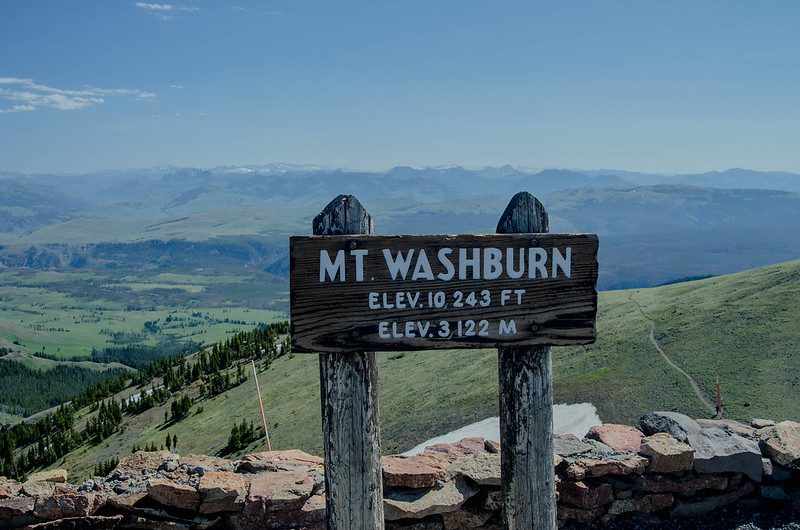
Yellowstone Park is home to an endless spaghetti maze of twisting, winding trails, but Mount Washburn is undoubtedly one of the highest and most bone chilling. It’s a 3000 metre high, 6 hour long hike with a constant blowing wind, and one of the last places in Yellowstone park where the snow melts each summer.
Making matters worse, it’s also a prime hotspot for grizzly bears. The grizzlies are drawn here for one simple reason: the endless supply of whitebark pine trees, a relic of the last ice age which only grows far above the usual treeline of Yellowstone. Every year, squirrels pick and bury the tree’s nuts in their thousands, before grizzlies arrive on the scene and use their supersonic sense of smell to greedily dig up the stashes. These nuts have a massive protein and fat content, and if it’s a productive season, then grizzlies prefer them even to berries.
This isn’t a route to be taken lightly: dogs are banned from Mount Washburn, and so is leaving the trail. Unlike Fishing Bridge, the grizzly bears peak here during fall, mainly because that’s also the peak of whitebark pine nuts. It would be oh-so-easy to mix up the dates in your head and stumble into the arms of a seemingly friendly grizzly. Yellowstone’s website states simply that “Hiking this trail is not recommended in September and October“. Paw prints are abundant on this high altitude route, as are trees which have ominously been stripped of their bark by grizzly bears with itchy backs.
| 3 | Old Faithful |
It’s said that Yellowstone park is the world’s most inevitable volcanic eruption, a 22 mile hotbed of pulsating tectonic activity whose eruption could fundamentally alter life on Earth as we know it. The problem is that nobody knows the exact date for this apocalypse, but one sneak preview you can see right now is Old Faithful, a geyser located in Central Yellowstone which sends a red hot plume of boiling water to the sky approximately every 80 minutes.
Tourists adore Old Faithful, and watch its eruptions with a keen eye from the wooden boardwalks, but it’s also popular among grizzly bears. Back in 2009, a grizzly bear was captured on video chasing a herd of bison right past Old Faithful itself.
In a photographer’s dream shot, the bear was framed to perfection with spouts of geyser water shooting up in the background, before continuing on past the wooden visitor’s centre. Had this occurred in high summer, the complex would have been packed with visitors, but it was merely April instead, with piles of melting snow lying all over the place.
August 2018 saw another incident, when a 10 year old boy was knocked to the ground by a spooked mother grizzly (whose life was spared) on the Divide trail just to the southeast. In June 2020, a 37 year old woman was knocked over and scratched by a bear on the nearby Fairy Falls trail, a winding path with no visibility. Old Faithful is a busy place with plenty of rangers, but the bears will always have the final word.
| 4 | Lamar Valley |
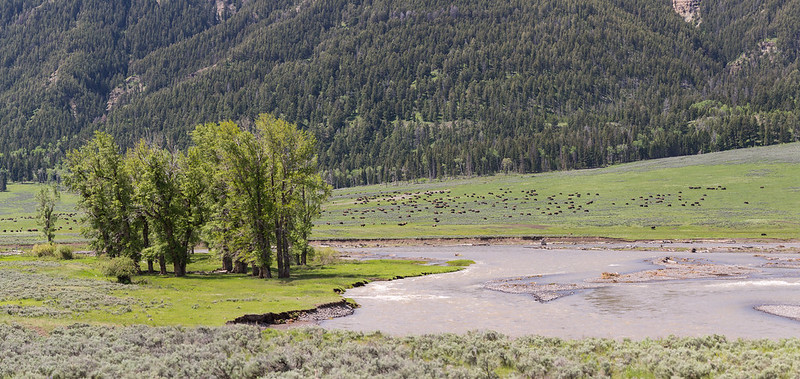
One of the true wildlife havens of Yellowstone Park, a place where you can witness brown bears, black bears, eagles, bison, elk and grey wolves prowling the plains in complete harmony. The Lamar valley begins at the northeast entrance of Yellowstone and is 29 miles long, with a well-paved road passing directly through the centre.
This is the only Yellowstone road to be open all year long, and drivers are encouraged to scan the rugged mountain slopes avidly for grizzly bears patrolling around. For Yellowstone’s authorities, this is the perfect safer option for less experienced bear watchers such as families with kids, and the slopes of Mount Norris and Specimen Ridge tend to be particularly packed with these brown or occasionally blond dots. There’s also multiple subroads leading to car parks where families can wait for friendly (or hungry) bears to come and say hello.
The Lamar Valley is a wide, meadowed valley with a raging river running through the middle, and wide meadows means large herds of bison. If you’ve always been obsessed with interspecies warfare (who hasn’t?), then the Lamar Valley is an unbeatable spot for seeing a grizzly trying to take down some prey, or wolves and grizzlies trying to displace each other from an irresistible bloody carcass. Ideally, this would all be happening to a soundtrack of the Lion King funnelled through a Yellowstone Park remix machine, but life isn’t perfect.
| 5 | Heart Lake |

One of the eerier, creepier bear hotspots of Yellowstone park. Heart Lake lies to the southwest of the more famous Yellowstone lake, and is much smaller, but also wilder and more secretive. This is a humid place of flies and mosquitoes where you could easily walk into the deceptive shallow waters and emerge with 20-25 leeches sucking on your legs.
Every year, Heart Lake is closed to public access from April 1st to June 1st, and the reason? You’ve got it – legions of hyper alert grizzly bears patrolling its shorelines. Heart Lake is a primetime fishing spot, a world renowned spot for mountain whitefish, cutthroat trout, and lake trout. Despite the restricted access due to bears, anglers with no fear are always eager to get their fishing rods into this lake, particularly given that lake trout was introduced illegally in the 1800s and there are no restrictions on catches.
The problem, or maybe the fun part, is that grizzly bears have the same idea. One incident happened back in 2017, when a 5 year old male bear was shot dead near Heart Lake after a 2 year rampage. In 2016, the bear had rummaged through the backpacks of unsuspecting campers and ransacked their tent, and the final straw came on August 27th 2017 when the bear stole and devoured a tourist group’s entire food stash. A backcountry pass is mandatory for visiting this bear hotspot, and bear spray is strongly recommended.
| 6 | Grizzly overlook |
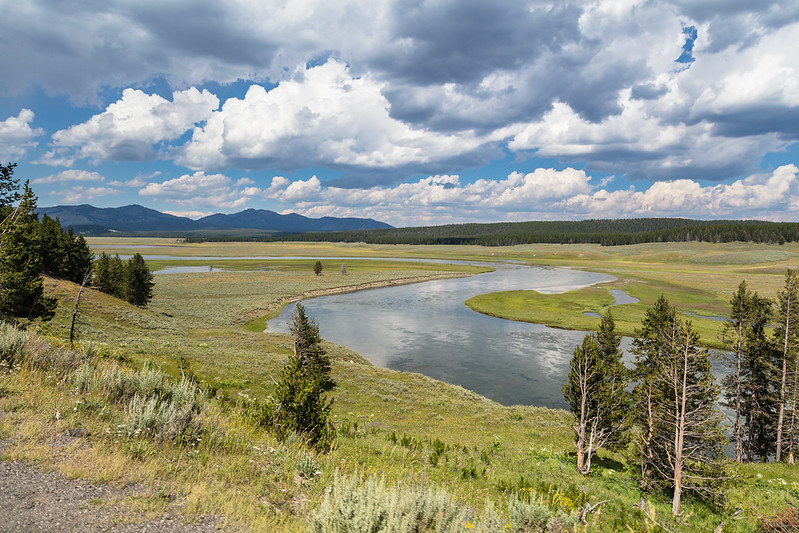
For once, it’s not just a name – stand on this rocky viewing platform and if the time is right, you could see huge numbers of grizzly bears patrolling the plains before you. This popular tourist spot has a 20-25 space car park (which is in serious need of refurbishment), and is located in the Hayden valley of Yellowstone’s mid-east, a valley which runs just northwards of Yellowstone lake and Fishing Bridge.
The Hayden Valley is bisected by the Yellowstone river, with lush, flat meadows on either side where grizzlies can hunt for bison and which act as flood plains. The viewing point is surrounded by fir trees, but these have a perfect parting to allow a view of Hayden valley for approximately 10 miles into the distance, ending at the distant mountains. Armed with binoculars and patience, your chances of seeing a grizzly during spring and autumn are close to 100%, while bird lovers can watch geese, pelicans and swans gliding serenely down the Yellowstone river.
One bear incident happened in summer 2017, when a bull elk carcass washed up on the river shore just 100 yards from the nearby road. It had either been hunted, run over, or died of natural causes, and before long, several large bears were duelling over the carcass in plain sight of transfixed tourists.
| 7 | East entrance roads |
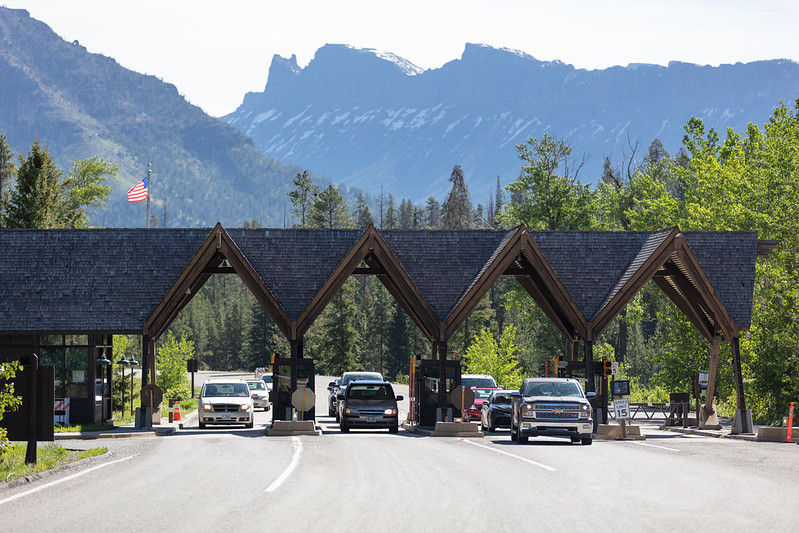
In Yellowstone park, the west entrance is typically the busiest among tourists, but it’s the east entrance which is a notorious hotbed of grizzly bears. The entrance itself is grizzly capital USA, and so is the long winding entrance highway that stretches for 27 miles towards Lake Yellowstone and Fishing Bridge. This is a classic highway for bear jams where all traffic grinds to a halt, where the eyes of a keen bear tourist should be glued to car windows at all times. The first section of the highway is flanked by the Swan Lake meadow flats, which are perfect for spring bears, while the middle section climbs the 2958 metre high Sylvan Pass, which is perfect for summer bears.
One famous resident is Raspberry the bear, born in 2008. Like sow 399 of Grand Teton, Raspberry has taken to raising her cubs by the roads to protect them from aggressive back country males, and consequently, she is unusually habituated to humans. In 2016, she gained new fans for her adorable bear cub Snow, who still roams the east entrance highway as an adult. Raspberry has also stuck to her traditional turf, and in 2020, she gave birth to a new cub called Jam.
Unfortunately, rangers are increasingly worried about this Yellowstone bear hotspot, as the Sylvan pass section is so winding and treacherous that it would only take one overeager driver to hurtle round a bend too fast and take out Raspberry or one of her friends forever.
| 8 | Pelican valley |
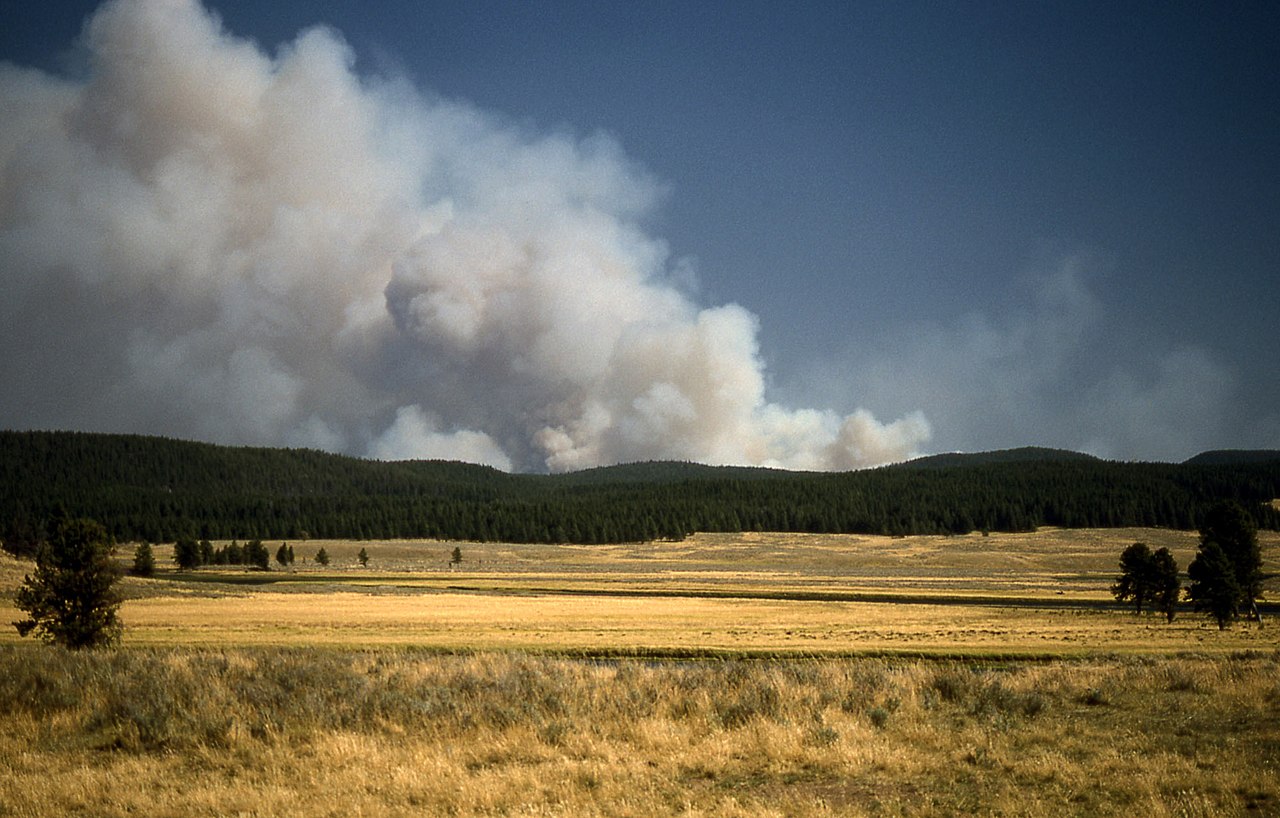
This bear hotspot has some of the tightest visitor rules in Yellowstone Park, for the sake of people’s safety. Night time trekking is permanently banned, and from April 1st to July 3rd, Pelican valley is closed to human beings entirely. Pet dogs are permanently banned.
The reason is simple – Pelican Valley is considered by wildlife biologists to be the most suitable piece of raw grizzly habitat in the entire USA. It’s located in the park’s east, directly northeast of Yellowstone Lake, and if you parachuted in, you’d probably be unable to tell whether it was the 2020s or the 1200s. It’s a windswept, moderately flat valley, running along the (unsurprisingly) bird-filled Pelican creek, with wooden bridges galore. Because it’s 1 mile wide and relatively treeless, your odds of seeing a grizzly bear walking the grassy slopes through your binoculars are extremely high.
One special feature of Pelican valley is Turbid lake, a misty blue lake surrounded by yellow pools of sulphur coming up straight from the Earth’s mantle. The lake’s shores are often littered with elk carcasses, and bones surrounded by giant grizzly paw prints, making it an awe-inspiring, yet slightly creepy place, like Yellowstone’s own elephant graveyard.
Despite the iron regulations, the death toll in Pelican valley is a surprising zero, but there’s a first time for everything.
| 9 | Tower-Roosevelt |
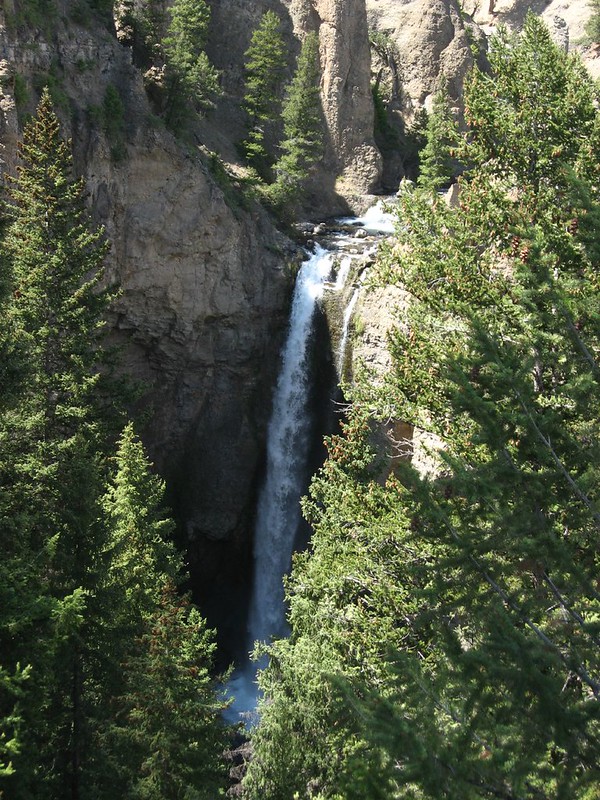
The so-called Grand Canyon of Yellowstone, a tourist spot renowned for its towering cliffs. This bear hotspot is named after the 132 foot Tower Creek Waterfall, a moderately wide, yet torrential plume of water which plunges straight into the rocky canyon below, a drop which you would have approximately a 1% chance of surviving. Before the fall, the river winds through a series of jagged volcanic spires. The earliest European explorers were amazed by Tower Falls, as were later gold prospectors, and a vivid painting by Thomas Moran in 1872 was partly behind the original decision to create Yellowstone park.
The nearby Roosevelt Lodge (created by President Teddy Roosevelt), café and campground complete the roster of attractions, but despite being comparatively more civilised compared to say, Pelican Valley, grizzlies are a constant presence here. Tower-Roosevelt is situated on the western fringes of the grizzly-packed Lamar Valley and they have no qualms about straying over for visits.
Tower Roosevelt isn’t an official Bear Management Area itself, but it’s surrounded by grizzly armies on all sides, with Mount Washburn BMA to the south and Blacktail BMA to the west. The popular Tower Falls overlook lies just 150 yards from the car park, and the winding path is an excellent bear viewing point, where the wide-open vistas become easily visible for a brief moment before the path curves back towards the rocky canyon. On March 15th 2017, the first newly awakened grizzly of the Yellowstone season was spotted just west of Tower-Roosevelt.
| 10 | Gneiss Creek |
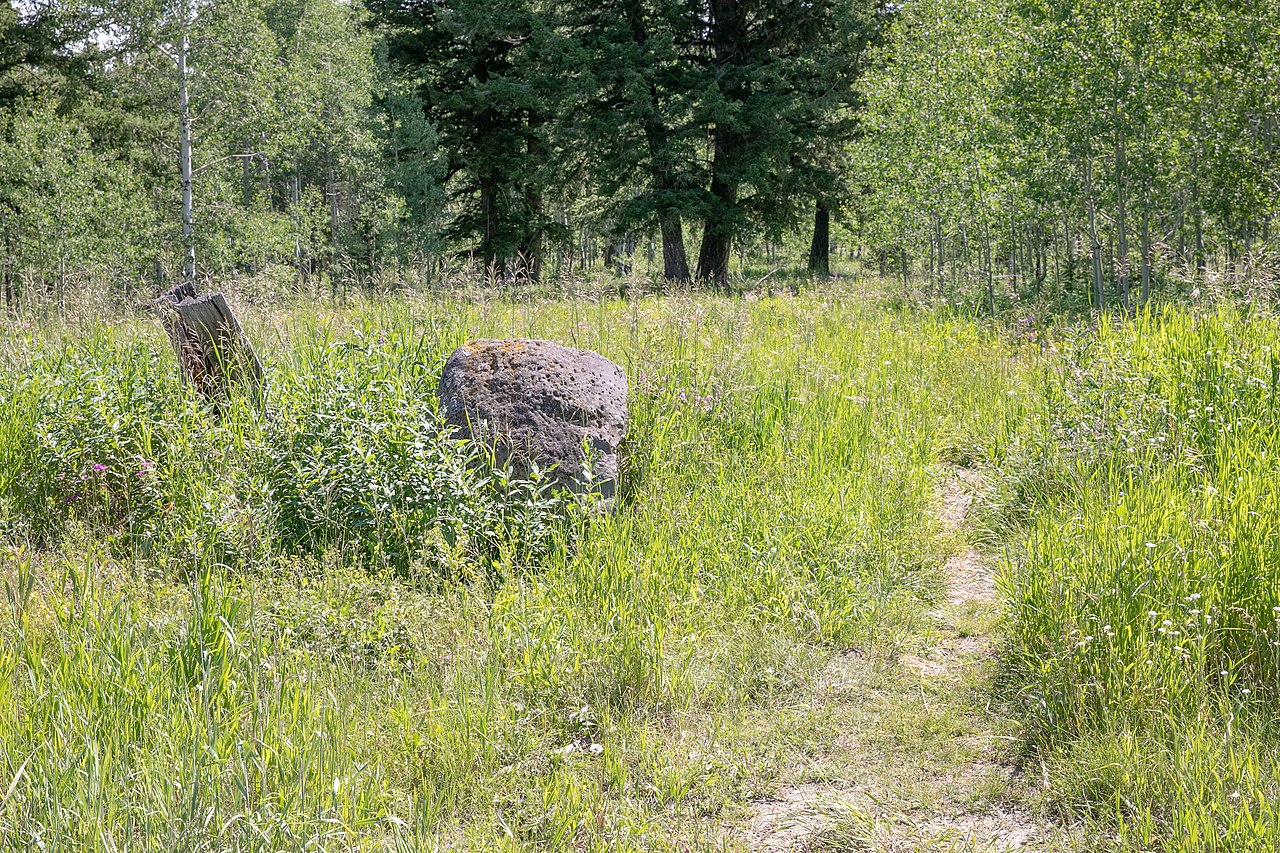
A lusher, less mountainous bear hub, which wouldn’t be out of place in sleepy southern England or the old tales of Huckleberry Finn. This 13.9 mile trail lies in the northwesternmost reaches of Yellowstone park, just over the border in southeast Montana. The attraction for grizzlies here is simple – fish, fish, and more fish. Despite the name, Gneiss creek trail leads past numerous bodies of water such as Duck Creek, Campanula Creek, Gneiss creek itself, and Richard’s creek, all swimming with dense schools of trout.
The large brown trout species, for example, can grow to a tasty 4 feet, and is found abundantly in Duck Creek, while Gneiss creek specialises in rainbow trout. All this makes the Gneiss creek trail a fisherman’s paradise, but also a grizzly bear paradise. It’s perfectly normal for overenthusiastic tourists to hike towards Gneiss Creek, only to be stopped dead in their tracks by a “Trail Closed” sign planted just hours earlier due to a strong-smelling moose carcass.
The first 8 miles pass through the heart of the Gneiss Creek Bear Management Area (see this handy map), which is completely closed to tourists from March 10th to June 30th. From July 10th to November 10th, only on-trail access is permitted – unless you fancy getting a little too intimate with the local grizzlies. In winter, the area is also home to the 14 mile long Gneiss ski trail – watch out for bears awakening from hibernation. This is a windy bear hotspot, where the constantly battered trees sometimes grow sideways.
The post 10 Bear Hotspots Inside Yellowstone Park appeared first on Bear Informer.
]]>The post The Grizzly Bears Of Denali: 10 Facts appeared first on Bear Informer.
]]>| 1 | True bear country |
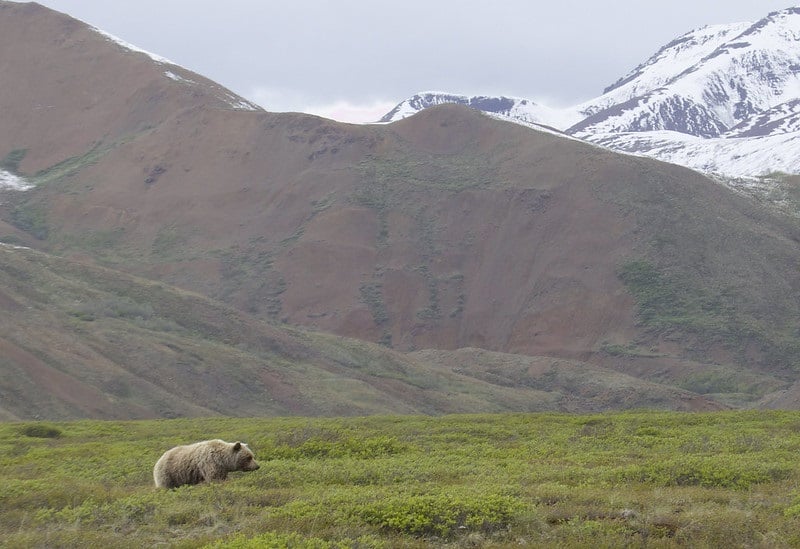
Denali National Park was first established back in 1917, and is a sprawling area of rugged semi-wilderness located 240 miles north of Anchorage. It’s home to the tallest mountain in North America, which stands at 6190 metres and is known as Mount McKinley to Westerners and as Denali to Native Americans.
However, Denali is also home to something else: 300-350 grizzly bears, spread across 4.7 million acres of land. These grizzlies roam the park alongside moose, caribou, arctic ground squirrels and dall sheep, and while they probably debate it amongst themselves, the bears are undeniably top of the food chain.
These are inland bears, with very little fish to eat, and consequently, Denali’s bears are far smaller than those of Katmai National Park (where “grizzly man” Timothy Treadwell used to hang out). 600 pounds is considered to be a large male, compared to 1200 pounds on the salmon paradise of Kodiak island.
Nor does the population reach the 700 grizzlies that Yellowstone boasts, but what Denali does have is stability: they never plummeted to the level of 150 bears like Yellowstone did in the 1970s when garbage problems were at their peak.
The bears here have a distinct yearly pattern. In spring, they stick to the valley floors and low hills, whereas in summer, they ascend to the grassier high and middle slopes. Paw prints have even been found in the snowfields of Mount Denali itself. In late summer and autumn, they descend to the valleys again, making August or September the perfect time to spot a Denali bear.
| 2 | Famous for being blond |
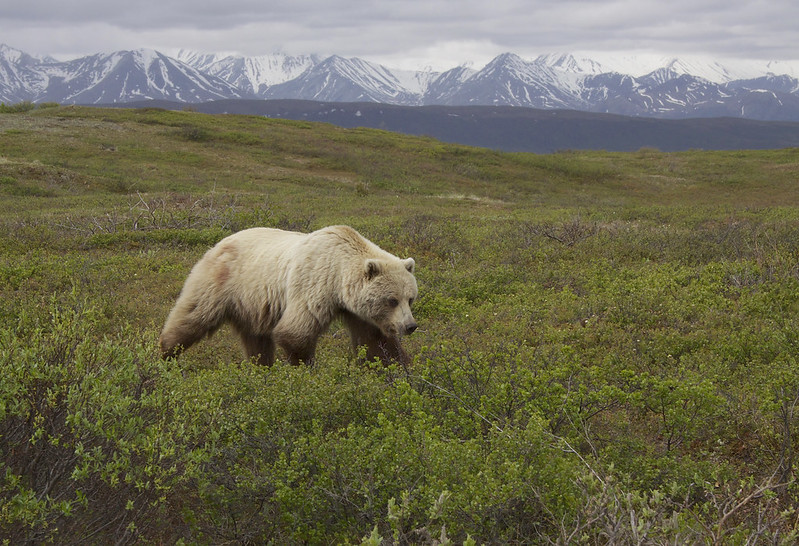
Blond grizzlies aren’t particularly unusual around the world. They’ve been spotted in Russia and Yellowstone Park alike, but Denali has a disproportionately high amount of them. Why? Nobody knows. All bears have brown, near black, and blond colour phases, activated by genetics, but there’s no unique evolutionary pressure for Denali to create blond bears. There’s plenty of snow fields where camouflaging could be beneficial, but not above and beyond other Alaska locations. It was probably a happy accident where a group of blonder than average bears happened to be the first colonisers, creating a blond gene pool.
These blond bears have even been given the nickname of Toklat bears, after Denali’s Toklat river. Some of the bears are blond all over, but others have amazing blond rings around their chests, or are blond with brown-coloured legs.
Adolph Murie spent 25 summers studying the grizzlies of Denali, and blond bears popped up repeatedly in his journals. On June 25th 1964, a photographer told him that a blond grizzly had “exploded” out of the bushes towards a spiky porcupine, and sure enough, when Murie arrived, the blond bear was rubbing at its paw anxiously. On June 6th 1965, Murie observed a blond mother and blond cub run riot on a heavily ridged mountainside, spooking 5 herds of caribou, until they finally located a bloody carcass and spent 25 minutes feeding. They probably weren’t blond after that.
| 3 | Encounters in cars are common |
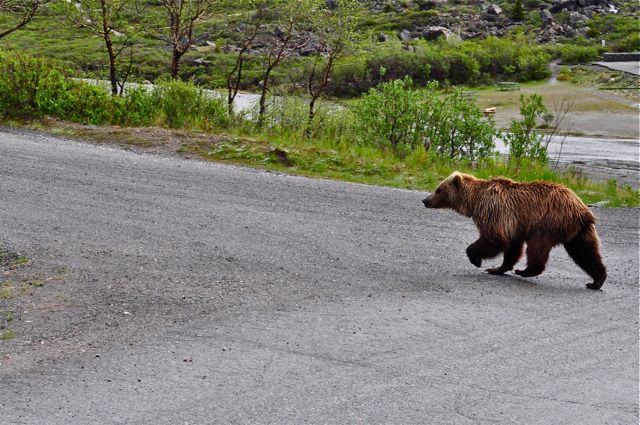
The bears of Denali are also far easier to spot compared to Banff or Katmai, because Denali is a relatively unforested national park. A large swathe consists of open tundra lowland, covered with shrubs and berry bushes. The rest is steep mountainsides, and because fully paved roads travel through the heart of the park, it’s easy to park your car and observe the uninterrupted landscape for miles around. You can scan the horizon for brown or blond dots amid the snow patches, or keep your eyes perfectly still until they register a slight movement.
Because black bears prefer forests, it’s actually easier to spot the larger grizzly in Denali National Park. The internet is packed with stories of bears devouring shrubs right by the road, creating an all-consuming temptation for drivers to stop and hug them
Bear jams are equally common. In 2015, a mother and her 2 near-adult sized cubs were awarded National Geographic’s photo of the day when they blocked the Park road, a private road open for 5 days each summer. This video shows 3 cars stuck behind a relaxed looking grizzly bear on a tricky downhill mountain road. At one point, it seems like the bear has learnt the art of politeness and is sticking to the side of the road, but the next second, he darts back across. Finally, the grizzly climbs a muddy bank between a curve, giving the cars a brief chance to escape, until they succumb to the urge to take pictures instead.
| 4 | Survives on tough, chewy roots |
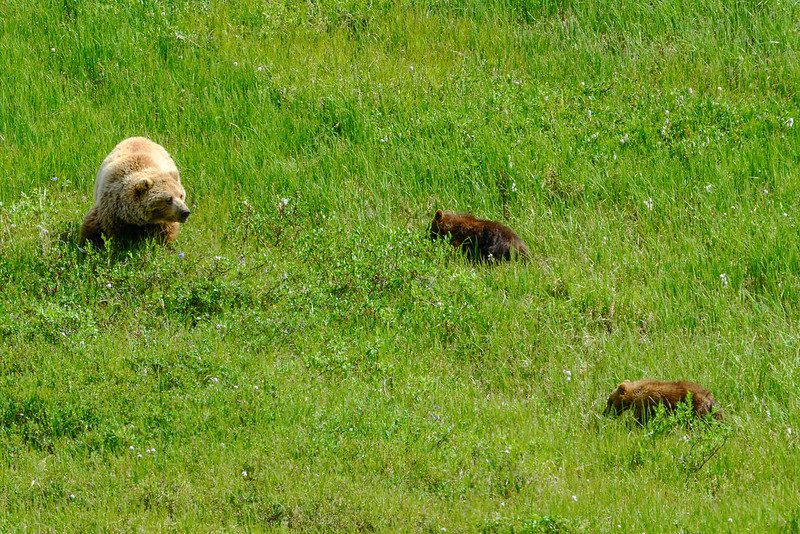
As the Denali bear first emerges from hibernation in April, there are no berries to munch on and certainly no schools of salmon to devour. Their main choice is the long, hard school of digging for the thick fleshy roots of peavine plants (Hedysarum alpinum americanum), which look like a cluster of colourful lilac flowers. For mysterious reasons, this is the only root that Denali bears dig for seriously, except for occasional rock fireweed and coltsfoot. It’s said to have the flavour of garden peas, and the peak digging season in Denali is the month of May.
To acquire the delicious peavine, the bear uses its massive muscular hump to tear into the soil, before using its entire body to pull the exposed roots free. The cubs, meanwhile, nose through the mother’s diggings to find the roots which she’s missed. Peavine is particularly common by the rivers of Denali such as the Toklat, and in the densest spots, bears can dig so relentlessly that the soils resemble a ploughed field afterwards. Some years, a patch will be completely and utterly destroyed, and the bear won’t return for 2 years, before the ecosystem recovers as if by magic.
In early June, this root-munching party suddenly stops, and the Denali bears move to new pastures: high altitude mountain slopes where they can graze on grass and sedges like an alpine cow. Half of these grasses are barely digested – the bears are merely buying time.
| 5 | Blueberry addiction (it’s a problem) |
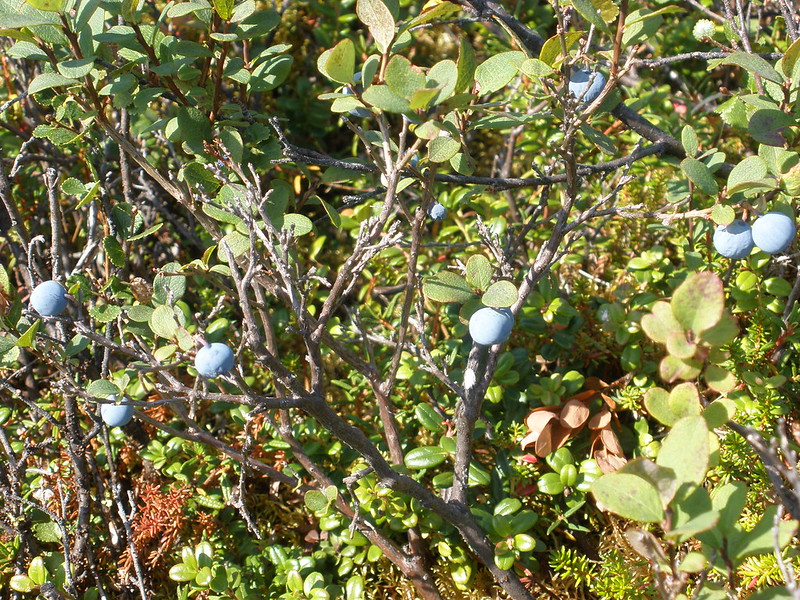
Late summer or autumn is when the party really gets started, as the bears of Denali switch focus to berries, and in particular, the common blueberry. Hikers are often shocked at the millions of blueberry plants which cover almost every inch of Denali’s lowlands. The bears have no patience whatsoever and usually start devouring the blueberries long before they ripen. Bears can spend hours in a single patch, using their prehensile lips to grip the branches and rip the berries off, making up for their lack of fingers.
Soapberries are another Denali bear favourite, a tiny red berry which grow in dozens on a single bush. During the height of its mad hyperphagic feeding season, a Denali bear can eat 200,000 soapberries (also called buffalo berries) per day. Humans hate them (hence soap-berries), but bears adore them because of their abundant amino acids. The rule of thumb is that if a distant Denali bear is bopping its head up and down, it’s snacking on blueberries, but if it’s moving its paws from side to side, then it’s probably snacking on soapberries.
Cranberries are also common in Denali, but they tend to go ignored, except in spring and early summer when other berries are scarce. Completing the “big three” is the hard, black crowberry, which are common from the lowlands to all but the highest slopes. These glossy berries measure 1/3 inch across, bigger apiece than soapberries, and have a bland taste to humans, but not to bears.
| 6 | Bear assaults from the vaults |
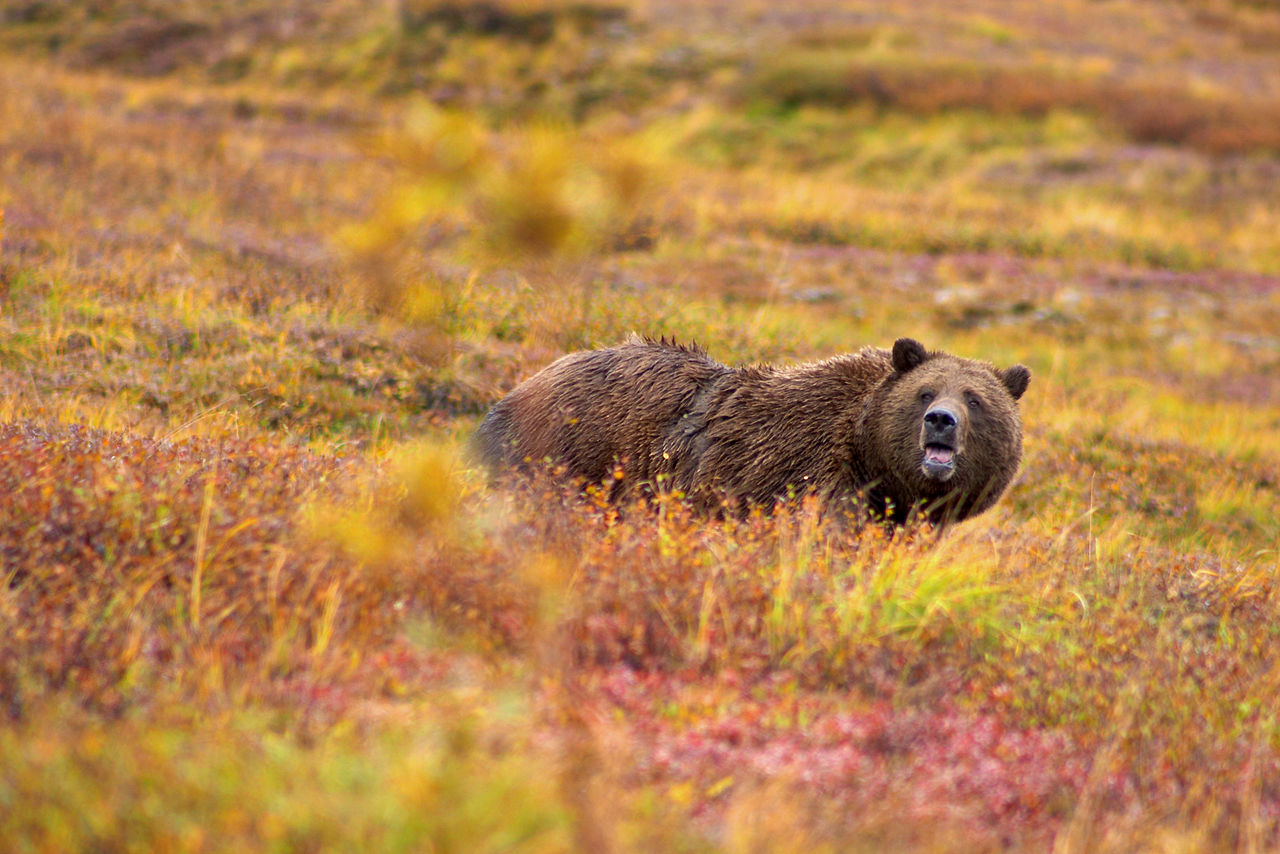
Sometimes it feels like there must be one bear hotspot on Earth where they behave just like your favourite teddy bear, but Denali isn’t that magical place. They’re the same as any bears – peaceful if you have the secret bear wisdom, but undoubtedly dangerous if you don’t.
August 4th 1961, for example, saw a totally unprovoked attack. Ecologist Napier Shelton was wandering the slopes of Igloo Mountain examining the forests, when he heard an ominous growling. Turning around, he saw a large grizzly charging out of the willow trees only 10 feet away. He was lucky that the 25 foot tree he was examining had wide, horizontal limbs extending almost to the ground, and up the tree he went.
Unfortunately, the bear managed to grab his ankle, sinking its paws deeply into his calf before slipping down again, and dragging Shelton partly with it. The bear recovered and climbed high once again, this time biting Shelton’s thigh. With his other free leg, still clutching the tree, Shelton kicked and kicked. The bear let go, and circled the tree two or three times, before deciding to leave.
Shelton stayed in the tree for half an hour before daring to climb down. He lived, but suffered deep claw wounds, and the doctor claimed to have found traces of blueberry juice in them! Lesson one – never underestimate a Denali grizzly.
| 7 | Rules and regulations |
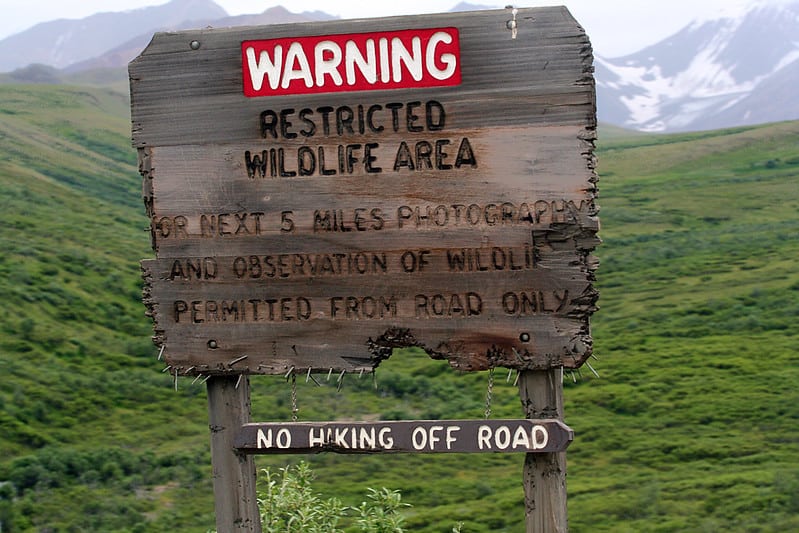
Every national park in America is allowed to make their own rules, and one of the biggest differences in Denali is that straying within 300 yards of a grizzly bear is forbidden. That’s much larger than Katmai National Park’s 25 yards, where the bears are far more habituated to people (but fortunately not the taste of them).
A big difference to Yellowstone is that bear resistant food containers are mandatory in Denali. These are unbreakable canisters made from futuristic forms of plastic, which require extremely precise motor skills to open – this prevents the bears from getting addicted to human foods and becoming “nuisance bears” who will inevitably get shot. Unlike parts of Canada, there’s no strict requirement to bring bear spray to Denali, although the NPS highly advises it.
As of February 2010, it’s now legal to bring guns into all sections of Denali, although firing them remains illegal. Beforehand, two thirds of the park were a gun free zone, and in May 2010, there was controversy when a grizzly bear charged from the thickets and was shot dead by an unsuspecting hiker wielding a .45-caliber semiautomatic pistol.
Naturally, route restrictions must always be obeyed, and like in Yellowstone, it’s common to saunter along to your favourite route from last summer and find a stark red and black sign reading “trail closed! bear in the area“. The sign continues with “We share this landscape with bears. Human activities will resume when the bear moves on”.
| 8 | More tales from the vaults |
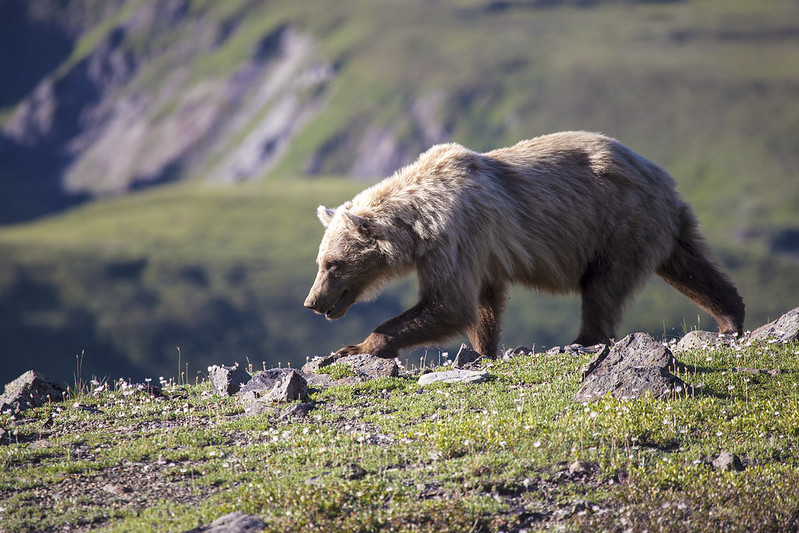
From 1922 to 1970, esteemed naturalist Adolph Murie spent 25 summers in Denali National Park observing bears, sometimes doing nothing other than watching them eat berries for hours. Murie had already pressured Yellowstone Park into halting its wolf killing program in the 1930s, and when he died in 1974, his son finished and published his manuscript, simply titled “The Grizzlies Of Mount McKinley”. It contains hundreds of obscure bear tales, and in one, a small bear unknowingly wandered towards 12 wolves on September 4th 1964, who quickly took notice and surrounded him. The bear turned to confront the alpha wolf, but was forced to spin around repeatedly as others closed in on its rear. This stand off lasted for 5 minutes, until suddenly, all 12 wolves decided to give up.
In late July 1963, Murie observed 2 bears feeding peacefully on a mountainside. They were 200 yards from a fox den, and soon, a small fox family of 3 emerged and watched the bears cautiously. The bears stayed in place all day, minding their own business, and by the afternoon, the slope was a fairytale scene of 2-3 alert foxes and 12 extremely paranoid looking arctic squirrels.
Murie rarely saw wolverines interact with bears, but one story from August 7th 1961 was particularly telling. A wolverine was wandering towards a river bar, looking very relaxed, having no idea that a 500 pound grizzly bear was ahead. When a bear came into view, the wolverine stopped dead in its tracks, span around 180 degrees, and ran like the wind, without stopping for 100 yards. The bear hadn’t even noticed.
| 9 | More vegetarian than average |

If a Denali bear experienced the taste of salmon, then he’d pack his bags and be off to Brooks Falls – no doubt about it. But compared to Katmai National Park, salmon is in very short supply in Denali. Except for sections of the Toklat river, the annual migration routes simply don’t pass through the park. Other sources of animal flesh are equally hard to come by, meaning that Denali bears are comparatively vegetarian. For example, Denali has approximately 1760 caribou, but within days of birth, they’re already speedy enough to dodge a hungry bear. The average bear snags just a couple of calves per year, and it’s a similar story for the 1800 moose in Denali. Moose mothers have even been seen goring black bears before.
Denali is packed with Dall Sheep – they’re the reason why Denali National Park was first created in 1929. They look like a soft target, but dell sheep are famous for their razor sharp “bear senses”, positioning themselves on crumbling mountainsides with supreme tactical accuracy. They can also outrun a charging bear surprisingly easily.
The only safe and reliable option for a meat-hungry Denali bear is the arctic ground squirrel, small furry mammals which cover almost every square foot of the park. It doesn’t matter how many squirrels they eat – they constantly regenerate. The bears’ strategy is to sniff them out with their supersonic sense of smell, and rip apart the soil to expose their underground dens. Sometimes they’ll just wait with their head at the entrance.
| 10 | Only one death ever |
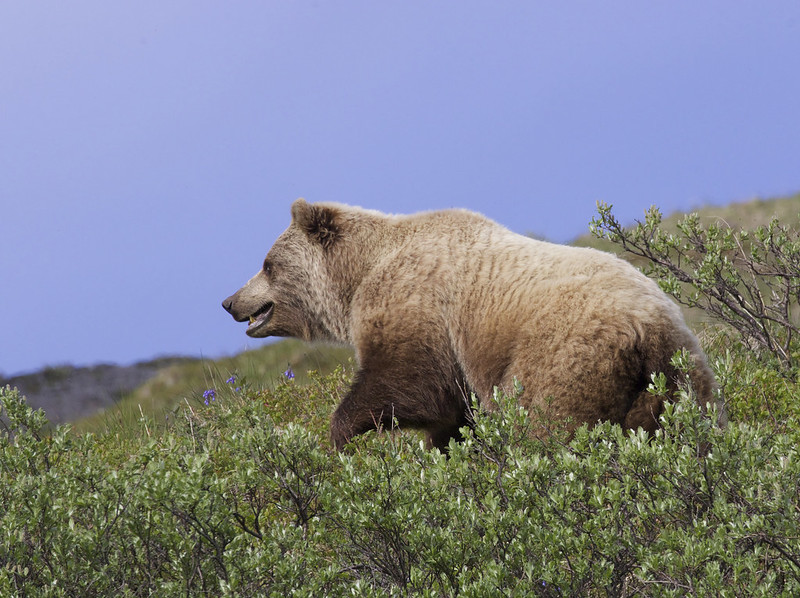
Denali National Park is “bear country” proper. The moment you step across the border, a sound effect will ring out and your place in the food chain will tumble around 10 points. Yet in the park’s 104 year history, there has only been a single death from grizzly bear activity. Like anywhere, the bears are no bloodthirsty monsters, just twitchy and unpredictable animals who fear you more than you fear them.
The park was established on February 26th 1917, and the first fatal attack took place 95 years later on August 25th 2012. Richard White, 49, was an amateur photographer wandering the banks of the Toklat River, a well known bear hub. He spotted a male grizzly feeding on willow trees innocently, and spent the next 40 minutes taking photos.
Unfortunately, he strayed to within 50 yards, much closer than the quarter of a mile recommended by Denali rangers. Later that day, fellow hikers stumbled upon his backpack, followed by scraps of torn clothing and blood. Rangers activated their helicopter, and while flying over the shores of the Toklat river, they spotted a large grizzly 150 yards below. It was sitting on human remains, guarding a “food cache” stored for later. Because the bear now had a keen taste for human flesh, a male trooper was forced to shoot it.
Images recovered from White’s camera proved the timeline of events. This was a true “fatal last photo” scenario, but luckily, the odds are still a million to 1 that you’ll survive your first summer hike in Denali (the second is debatable).
The post The Grizzly Bears Of Denali: 10 Facts appeared first on Bear Informer.
]]>